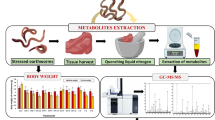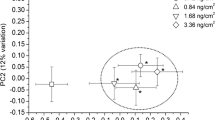Abstract
Earthworms, by their soil-dwelling nature, feeding and burrowing activity in the soil, are known to increase soil fertility and are also referred as nature's plough by Charles Darwin. They ingest organic matter from the soil, are exposed to microbes and pollutants, and excrete casts in the soil adding to the soil fertility. Although earthworms are essential for soil mineralisation process, their metabolism and impact on environment are not well studied. In this study, we investigated the gut voided biochemical constituents of Lampito mauritii (L. mauritii) and analyzed by FT-IR and GC–MS studies. The results indicated significant findings, including identification of unique biochemical components with 16 major compounds in L. mauritii with a significant peak at retention time 4.09 and other peaks at 4.13, 4.27, 4.53, 4.88, 5.44, 7.21 and 16.49 revealed by GC–MS analysis Our study highlights the expression of unique compounds in the earthworm. It emphasises that metabolism may play a predominant role in altering ingested components of soil organic matter, and the earthworm casts may have a positive impact on the environment.





Similar content being viewed by others
Availability of Data and Materials
All data are available.
References
Aceves-Ramos, A., R.A. Valdez, B. Gaona, K. Willms, and M.C. Romano. 2013. Steroid synthesis by Taenia crassiceps WFU cysticerci is regulated by enzyme inhibitors. General and Comparative Endocrinology 188: 212–217.
Aguirre-Becerra, H., S.A. Pineda-Nieto, J.F. García-Trejo, R.G. Guevara-González, A.A. Feregrino-Pérez, B.L. Álvarez-Mayorga, and D.M. Rivera Pastrana. 2020. Jacaranda flower (Jacaranda mimosifolia) as an alternative for antioxidant and antimicrobial use. Heliyon 6 (12): e05802.
Baker, G. 2007. Differences in nitrogen release from surface and incorporated plant residues by two endogeic species of earthworms (Lumbricidae) in a red–brown earth soil in southern Australia. European Journal of Soil Biology 43: S165–S170.
Blouin, M., M.E. Hodson, E. Delgado, G. Baker, L. Brussaard, K.R. Butt, et al. 2013. A review of earthworm impact on soil function and ecosystem services. European Journal of Soil Science 64: 161–182.
Butt, K. R., Lowe, C. N. Controlled cultivation of endogeic and anecic earthworms. In: A. Karaca (Eds.) Biology of Earthworms. Soil Biology, 2011, vol 24. Springer, Berlin. https://doi.org/10.1007/978-3-642-14636-7_7
Davinelli, S., M.E. Nielsen, and G. Scapagnini. 2018. Astaxanthin in skin health, repair, and disease: A comprehensive review. Nutrients 10 (4): 522.
Ghosh, S., M. Sadhukha, S. Rout, B. Malick, M.N. Hasan, and C. Mandal. 2020. Elemental analysis on the new species of earthworm from Orissa. Exploratory Animal and Medical Research 10 (1): 65–69.
Ghosh, S. 2018. Environmental pollutants, pathogens and immune system in earthworms. Environmental Science and Pollution Research 25 (7): 6196–6208.
Hattenschwiler, S., and P. Gasser. 2005. Soil animals alter plant litter diversity effects on decomposition. Proceedings of the National Academy of Sciences 102: 1519–1524.
https://mmrc.caltech.edu/FTIR/Nicolet/Nicolet%206700%20brochure.pdf
Julka, J.M. 1988. The fauna of India and adjacent countries: Megadrile Oligochaeta (Earthworms). Haplotaxida: Lumbricina: Megascolecoidea:Octochaetidae. Calcutta: Zoological Survey of India. xiv 400pp.
König, H. 2006. Bacillus species in the intestine of termites and other soil invertebrates. Journal of Applied Microbiology 101 (3): 620–627.
Kooch, Y., and H. Jalilvand. 2008. Earthworms as ecosystem engineers and the most important detritivors in forest soils. Pakistan Journal of Biological Sciences 11 (6): 819–825.
Li, H., X.R. Yang, J. Wang, G.W. Zhou, Y.S. Zhang, S.B. Lassen, Y.G. Zhu, and J.Q. Su. 2021. Earthworm gut: An overlooked niche for anaerobic ammonium oxidation in agricultural soil. Science of the Total Environment 752: 141874.
Lubbers, I., K. van Groenigen, S. Fonte, et al. 2013. Greenhouse-gas emissions from soils increased by earthworms. Nature Climate Change 3: 187–194.
Markman, S., I.A. Guschina, S. Barnsley, K.L. Buchanan, D. Pascoe, and C.T. Müller. 2007. Endocrine disrupting chemicals accumulate in earthworms exposed to sewage effluent. Chemosphere 70 (1): 119–125. https://doi.org/10.1016/j.chemosphere.2007.06.045.
Medina-Sauza, R.M., M. Álvarez-Jiménez, A. Delhal, F. Reverchon, M. Blouin, J.A. Guerrero-Analco, C.R. Cerdán, R. Guevara, L. Villain, and I. Barois. 2019. Earthworms building up soil microbiota, a review. Frontiers in Environmental Science 7: 81.
Miglani, R., and S.S. Bisht. 2019. World of earthworms with pesticides and insecticides. Interdisciplinary Toxicology 12 (2): 71–82.
Mudiam, M.K.R., R. Ch, and P.N. Saxena. 2013. Gas chromatography-mass spectrometry based metabolomic approach for optimization and toxicity evaluation of earthworm sub-lethal responses to carbofuran. PLoS ONE 8 (12): e81077. https://doi.org/10.1371/journal.pone.0081077.
Peng, J., J.P. Yuan, C.F. Wu, and J.H. Wang. 2011. Fucoxanthin, a marine carotenoid present in brown seaweeds and diatoms: Metabolism and bioactivities relevant to human health. Marine Drugs 9 (10): 1806–1828.
Phillips, H.R.P., E.M. Bach, M.L.C. Bartz, et al. 2021. Global data on earthworm abundance, biomass, diversity and corresponding environmental properties. Science Data 8: 136.
Sapkota, R., S. Santos, P. Farias, P.H. Krogh, and A. Winding. 2020. Insights into the earthworm gut multi-kingdom microbial communities. Science of the Total Environment 20 (727): 138301.
Schulz, K., S. Hunger, G.G. Brown, S.M. Tsai, C.C. Cerri, R. Conrad, and H.L. Drake. 2015. Methanogenic food web in the gut contents of methane-emitting earthworm Eudrilus eugeniae from Brazil. ISME Journal 9 (8): 1778–1792.
Swart, E., T. Goodall, P. Kille, D.J. Spurgeon, and C. Svendsen. 2020. The earthworm microbiome is resilient to exposure to biocidal metal nanoparticles. Environmental Pollution 267: 115633.
Wang, N., W. Wang, Y. Jiang, W. Dai, P. Li, D. Yao, J. Wang, Y. Shi, Z. Cui, H. Cao, Y. Dong, and H. Wang. 2021. Variations in bacterial taxonomic profiles and potential functions in response to the gut transit of earthworms (Eisenia fetida) feeding on cow manure. Science of the Total Environment 15 (787): 147392.
Wei, X., I. Koo, S. Kim, and X. Zhang. 2014. Compound identification in GC-MS by simultaneously evaluating the mass spectrum and retention index. The Analyst 139 (10): 2507–2514. https://doi.org/10.1039/c3an02171h.
Zhao, S., B. Wang, Z. Zhong, T. Liu, T. Liang, and J. Zhan. 2020. Contributions of enzymes and gut microbes to biotransformation of perfluorooctane sulfonamide in earthworms (Eisenia fetida). Chemosphere 238: 124619.
Acknowledgements
The author acknowledges, Director, NISER, Bhubaneswar, Odisha, India for the study. FT-IR based studies were done in Central facility of OUAT, Odisha, India under paid facility. The authors are grateful to Dr. Chandrakanta Mandal, Scientist Zoological Survey of India (ZSI) and Director ZSI for the taxonomic identification of the earthworm specimen.
Funding
No funding was received for the study.
Author information
Authors and Affiliations
Contributions
SG and AD performed the experiments, analysed the data and results, wrote, revised the ms and SG communicated the paper.
Corresponding author
Ethics declarations
Completing interests
None declared.
Consent to Participate
NA.
Consent to Publish
All authors consent to publish.
Ethics Approval
No vertebrate or human tissues were used. Earthworms are invertebrates, collected from local soil and recorded under Zoological Survey of India, Kolkata.
Additional information
Publisher's Note
Springer Nature remains neutral with regard to jurisdictional claims in published maps and institutional affiliations.
Rights and permissions
Springer Nature or its licensor (e.g. a society or other partner) holds exclusive rights to this article under a publishing agreement with the author(s) or other rightsholder(s); author self-archiving of the accepted manuscript version of this article is solely governed by the terms of such publishing agreement and applicable law.




